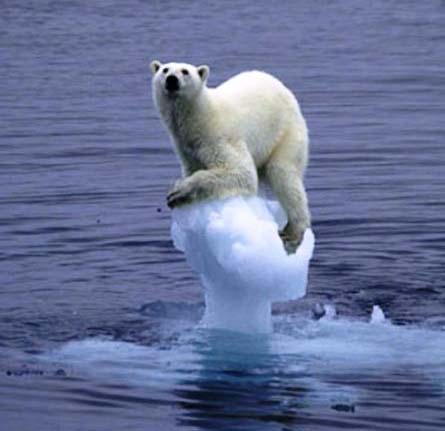 For those of you worried about this polar bear. Don’t be. It can swim. Very well in fact. The proof of this is that polar bears are the main danger on those intrepid enough to visit Jan Mayen Island. Jan Mayen Island (Coordinates: 70°59′N 8°32′W) is a volcanic island in the Arctic Ocean and part of the Kingdom of Norway. It is 34 miles long (southwest-northeast) and 144 square miles in area, partly covered by glaciers (an area of 44 square miles around the Beerenberg). It has two parts: larger northeast Nord-Jan and smaller Sør-Jan, linked by an isthmus 1.6 miles wide. It lies 375 miles northeast of Iceland, 315 miles east of Greenland and 625 miles west of the North Cape, Norway. The polar bears actually swim to this island from such as Greenland!
For those of you worried about this polar bear. Don’t be. It can swim. Very well in fact. The proof of this is that polar bears are the main danger on those intrepid enough to visit Jan Mayen Island. Jan Mayen Island (Coordinates: 70°59′N 8°32′W) is a volcanic island in the Arctic Ocean and part of the Kingdom of Norway. It is 34 miles long (southwest-northeast) and 144 square miles in area, partly covered by glaciers (an area of 44 square miles around the Beerenberg). It has two parts: larger northeast Nord-Jan and smaller Sør-Jan, linked by an isthmus 1.6 miles wide. It lies 375 miles northeast of Iceland, 315 miles east of Greenland and 625 miles west of the North Cape, Norway. The polar bears actually swim to this island from such as Greenland!
Independent Researchers have found that by using the Pacific Marine Atlas program to plot data from the entire ocean network of automatic measuring stations, there is was actually a downtrend in global sea levels over the past six years.
This discovery was made after analyzing the full 6-year dataset of ocean levels from 31st January 2004 to 31st January 2010.
By using the data from the ‘ARGO’ global network of sea level measurements it was found that ocean levels have actually been decreasing and not rising, contrary to global warming forecasters. This latest revelation is wholly contrary to claims by the Intergovernmental Panel on Climate Change (IPCC). The IPCC has continually argued that human emissions of carbon dioxide were causing the polar ice caps and thousands of glaciers around the world to melt so that such warming would cause global sea levels to rise, according to the IPCC’s 35 SRES scenarios, by up to one foot seven and three quarters of an inch this century.
These new revelations are bound to cause further dismay to climate alarmists reeling after a flood of scandals suggesting either corruption or incompetence by the IPCC in gathering climate data and projecting future trends.
The ‘ARGO’ project was set up in 2004 and is a collaboration between 50 research and operational agencies from 26 countries, with the United States contributing over half the total funding (as of December 2004). ARGO is a component of the Integrated Ocean Observing System and consists of a large collection of small, drifting oceanic robotic probes deployed worldwide. The data are transmitted to scientists on shore via satellite. There have been 3,198 of such probes set around the world’s oceans since November 2007.
The probes float as deep as one and a quarter miles. Once every 10 days, the probes surface, measuring conductivity and temperature profiles to the surface. From these salinity and density can also be calculated. The data collected are freely available to everyone, without restrictions.
Speaking the Truth unto the Nation
